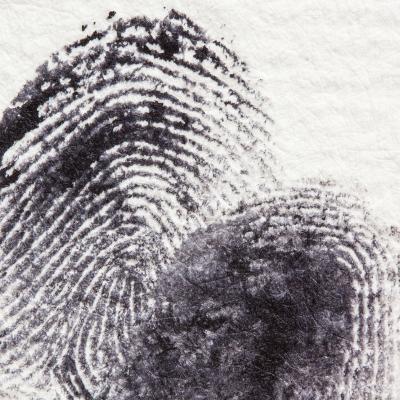Anúncios
Fingerprints are unique marks that every human being carries, even when it comes to identical twins. Although they share the same genetic code, these siblings have distinct fingerprint patterns. This phenomenon intrigues scientists and reinforces the complexity of human development.
During pregnancy, environmental factors play a crucial role in the formation of fingerprints. Internal pressures, position in the womb, and variations in amniotic fluid are determining factors. Thus, even with shared genetics, each twin develops their own individual marks.
Anúncios

How do identical twins’ fingerprints develop?
Identical twins, also known as monozygotic twins, come from a single fertilized egg that splits into two embryos. Although they share the same genetic makeup, their fingerprints exhibit unique patterns. The development of fingerprints is a complex process influenced by genetic and environmental factors. During the early stages of fetal development, the skin on the fingertips begins to form ridges, which eventually become the distinct patterns we recognize as fingerprints. These patterns are determined by a combination of genetic predisposition and random environmental influences that occur during the fetus’s growth.
As the fetus develops, the ridges on the fingertips are influenced by the fetus’s unique position in the womb, the pressure exerted by the amniotic fluid, and the growth of the skin. This means that even if identical twins have the same genetic information, their fingerprints can develop differently due to these varying conditions. The randomness of these environmental factors ensures that each twin has a distinct set of fingerprints despite their identical genetic origin.
Another significant aspect of fingerprint development is the timing and order in which the skin layers grow. The formation of fingerprints begins around the 10th week of gestation and continues to develop until birth. The ridges and patterns are formed by the interaction of the dermal and epidermal layers of the skin. As the skin grows and stretches, the patterns can change, leading to unique fingerprints for each twin. This fascinating interaction between genetics and environmental factors contributes to the individuality of fingerprints among identical twins.
In conclusion, the development of fingerprints in identical twins is a multifaceted process. Although they share the same genetic information, the combination of genetic factors and environmental influences during fetal development leads to the creation of unique fingerprints. This phenomenon highlights the complexity of human development and the intricate ways in which nature and nurture interact to shape our identities.
Advantages of Understanding Fingerprint Differences in Twins
Understanding the differences in fingerprints between identical twins brings several advantages, especially in fields such as forensic science, biometric identification, and genetics. One of the main benefits is the improvement of forensic investigations. In criminal cases, fingerprints are often used as a key piece of evidence. Recognizing that even identical twins have distinct fingerprints allows authorities to accurately identify individuals, avoiding wrongful accusations and ensuring that justice is served.
In addition to their forensic applications, the study of fingerprint differences in twins provides valuable insights into the nature versus nurture debate. By examining how identical twins, who share the same genetic makeup, develop different fingerprints, researchers can better understand the role of environmental factors in shaping physical characteristics. This knowledge can extend beyond fingerprints to other aspects of human development, offering deeper insight into how genetics and environment interact.
Furthermore, understanding the differences in fingerprints between identical twins can advance biometric identification technologies. As biometric systems become more prevalent in security and access control, recognizing that identical twins can have unique fingerprints is crucial for developing reliable identification methods. This knowledge can lead to improved algorithms and systems that accurately differentiate individuals, even in cases of identical twins.
Finally, the study of fingerprint differences can also contribute to medical research. Certain fingerprint patterns have been associated with genetic conditions and diseases. By understanding how identical twins can present different fingerprint patterns, researchers can explore the genetic and environmental factors that contribute to these conditions. This research can ultimately lead to better diagnostic tools and treatment options for various health issues.
How are twins’ unique fingerprints formed?

Fingerprint genetics play a crucial role. Fingerprint patterns are influenced by genetic factors but are not exclusively determined by them. Although identical twins share the same genetic code, the expression of these genes can vary, leading to different fingerprint patterns. This genetic variability is a key factor in understanding why identical twins have unique fingerprints.
Environmental factors can influence fingerprint patterns. The environment in which a fetus develops plays a significant role in the formation of fingerprint patterns. Factors such as the fetus’s position in the womb, the pressure exerted by amniotic fluid, and even the presence of other twins can impact how fingerprints form. These environmental influences add another layer of complexity to the development of unique fingerprints.
DNA and fingerprints are not the same thing. It is essential to recognize that DNA and fingerprints serve different purposes in identification. While DNA provides a genetic blueprint, fingerprints are a physical manifestation of skin patterns. Even though identical twins have identical DNA, their fingerprints can differ significantly, highlighting the importance of using multiple identification methods.
The biometric identification of twins can be unique. In the field of biometric identification, the uniqueness of fingerprints among identical twins is crucial. Biometric systems rely on the distinctiveness of fingerprints to accurately identify individuals. Understanding that identical twins can have different fingerprints ensures that biometric technologies remain effective and reliable in real-world applications.
Nature versus nurture affects the development of twins’ fingerprints. The debate between nature and nurture is exemplified in the study of fingerprint differences among identical twins. While genetics provide a foundation for fingerprint formation, environmental factors play a significant role in shaping final patterns. This interaction between genetics and environment highlights the complexity of human development.
Twins’ fingerprint patterns can vary significantly. Research has shown that identical twins can exhibit significant variations in their fingerprint patterns. These differences can manifest in the arrangement of ridges, the presence of certain patterns, and even the overall shape of the fingerprints. This variability emphasizes the uniqueness of each individual’s fingerprints, regardless of their genetic similarity.
In conclusion, the formation of unique fingerprints among identical twins is a fascinating interaction of genetic and environmental factors. Understanding how these elements contribute to fingerprint development can enhance our knowledge of human biology and improve applications in forensic science, biometric identification, and genetic research.
The Genetics Behind Fingerprints

Fingerprint patterns begin to form around the 10th week of gestation. At this stage, the interaction between the layers of the skin initiates the creation of the so-called “ridges.” Although DNA provides the foundation for this formation, it does not define the final pattern.
This genetic foundation is responsible only for general pattern characteristics, such as the tendency to form arches or whorls. However, the exact configuration of the lines is not genetically programmed. This means that genetics act more as a guide than a definitive roadmap.
Identical twins share this genetic foundation, but gene expression can occur differently. Small variations in this process are already enough to alter the final patterns. It is precisely this subtle differentiation that creates unique fingerprints.
Therefore, although genetics have a direct influence, they do not act in isolation. The interaction between hereditary and external factors is indispensable. This reinforces the idea that human uniqueness goes far beyond our genes.
The Role of the Environment in Fingerprint Development
During pregnancy, the uterine environment exerts a strong influence on fingerprint formation. The fetus’s position in the womb is a determining factor in this process. Each movement and bodily adjustment directly affects the forming skin.
The pressure of the amniotic fluid on the fingertips also interferes with this development. This contact changes how the skin layers interact, creating unique patterns. These small pressures are unpredictable and vary between twins.
Additionally, the rate of skin growth differs from one twin to another. This factor contributes to variation in ridge formation. Thus, even in a shared environment, the conditions are not exactly the same.
Finally, factors such as maternal nutrition and hormone levels also play a role. All of this combined creates a rich environment full of variables, responsible for the uniqueness of fingerprints. Each fetus experiences a unique “microenvironment.”
The Importance of Biometric Identification
Knowledge about the differences in twins’ fingerprints is essential for biometrics. Modern security systems depend on these characteristics to ensure accuracy. Even identical twins can be easily differentiated.
This discovery has led to significant advances in personal identification technology. Biometric algorithms have been improved to recognize nuances in fingerprints. This level of detail ensures greater reliability in authentication processes.
In addition to digital security, biometrics have been used in border control and banking institutions. The certainty that even identical twins do not have identical fingerprints reinforces the efficiency of these applications. This minimizes fraud and identification errors.
Therefore, understanding fingerprint uniqueness is crucial for advancing security. Technologies will continue to evolve, and the science behind fingerprint formation will become increasingly relevant. The future of biometrics depends on this knowledge.
Did you enjoy learning about why identical twins have different fingerprints?
In summary, exploring why identical twins have different fingerprints reveals a captivating intersection between genetics and environmental influences. The uniqueness of each twin’s fingerprints serves as a reminder of the complexity of human development and individuality. By understanding the factors that contribute to these differences, we can appreciate the intricate processes that shape who we are.
If you found this topic intriguing, there is much more to discover about the science of fingerprints, genetics, and human development. The world of biometrics and forensic science offers endless opportunities for exploration and understanding, inviting you to delve deeper into the fascinating realm of human identity.
Frequently Asked Questions
Why do identical twins have different fingerprints?
Fingerprints form in the womb. Even identical twins, who share the same DNA, have different experiences inside the womb. This causes their fingerprints to be unique.
What influences twins’ fingerprints?
Several factors can change fingerprints. This includes the twin’s position in the womb and the amniotic fluid. These conditions cause each twin to have their own unique mark.
Are all fingerprints unique?
Yes, all fingerprints are unique! It doesn’t matter if you are an identical twin or not. Each fingerprint is like a personal signature.
Are there other physical traits that identical twins share?
Yes! Identical twins share many physical traits, like eye and hair color. But they still have individual characteristics, such as fingerprints.
Can fingerprint studies help in investigations?
Yes, fingerprint studies are very important! They can help identify people in police investigations. Even identical twins are easily differentiated by their fingerprints.
